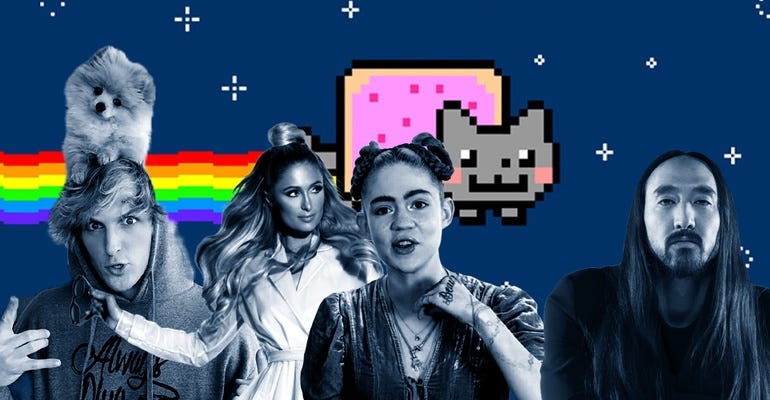1.4m Chamath Palihapitiya
8.2m Mark Cuban
2.2m Gary Vaynerchuk
657k Anthony Pompliano
1.7m Tim Ferris
1.2m Naval Ravikant
The numbers next to these names are each person’s respective number of Twitter followers. Collectively, they have over 15m followers. If their followers were citizens of a country, it would be the 73rd most populous country in the world (out of over 200 countries)! I specifically selected these people because they are investors, and observing them is more applicable to me versus other categories of celebrity, like Katy Perry for example.
This month’s sponsor is WhaleStreet 🔥🔥🔥
WhaleStreet are the DeFi engine that powers NFT economics. On a massive scale. They make huge currency swaps happen - or Whale Swaps as they're called - with very small slippage costs and without crashing the system. They also engineered the largest ever NFT bundle and fractionalized it into the historic B20 tokens. WhaleStreet is all about upside, so dip into their liquidity pools for rich rewards. For B20, join Discord.com/whale. And follow WhaleStreet at Twitter.com/whalestreetoffl
These investors can get into any deal, contact anyone, and get any meeting. Why? Because of their audience. Audience is power. It always has been and always will be. The internet has enabled us to grow our audiences by orders of magnitude. How did all of these people get such massive audiences? They relentlessly create content for others to consume. This content ranges from books to podcasts, to live streams and tweets.
Why does this matter for NFTs? Well, an audience is almost all that matters for (most) NFTs. These assets are collectibles, gaming items, pieces of art, virtual land, etc. - and most are highly subjective in value. There definitely is a class of NFTs that generate yield, and those assets can be quantifiably valued, but most NFTs are qualitatively valued.
For example, who were the artists that got accepted to sell their works at the famed auction houses Christie’s and Sotheby’s? It was not simply the early artists in the NFT ecosystem, it was the artists with existing massive audiences - Beeple and Pak. Combined, Beeple and Pak have over 4m+ followers on their social channels: Beeple with 2m followers on his Instagram and Pak with 2.4m followers on his Archillect Twitter.
How To Grow Your Audience
Content is king. We have all heard that before, and it is absolutely true. Look at Beeple and Pak and the amount of content they produce. Beeple has created one piece of art every day for 13 years, which is borderline insanity. Pak’s Archillect Twitter account tweets hundreds of times per day.
How did investor Anthony Pompliano get 600k+ Twitter followers? He writes an investor letter, releases a podcast, and creates a YouTube video every.single.weekday. The man is a savage, and I truly do not understand how he has the time. So, for those who want to grow an audience, simply start creating content like a madman.
How Does Audience Impact NFTs?
The NFT market is very young, immature, and highly subjective, meaning that there are specific people with followings that can have an outsized impact on different NFT projects.
The best example of this can be observed with people like Pranksy or Justin. Pranksy can tweet about a new NFT project he is launching and it can sell out that same hour. Justin can tweet about NFT projects, like CryptoCats and MoonCats, and have them both sell out within the day. This is the power of an audience.
I also use my audience for highlighting new projects I believe in. I recently incubated a project called Ethstory led by the data scientist takenstheorem, and the first series of works sold out during the first auction. There is an immense responsibility that comes with discussing different NFT projects because if you share something you truly do not believe in and are doing it for a quick money grab, the NFT community will see right through it and your “word” within the community will diminish.
Over time, I believe there will be more people within the NFT space that act as tastemakers or quasi-curators, which I think is positive for the ecosystem. The reason being is there is a deluge of information that is nearly impossible for a single person to keep up with. I know I can see which projects Pranksy or Justin are tweeting about and receive concise quality information about them. This quasi-curation acts as a filter and enables me to make faster decisions.
Audience is power, content is king, and the impact of an audience within the fast-paced, highly subjective, NFT space is outsized. Luckily, the quasi-curators have an incentive to act in good faith, or they will be punished via weakened influence.
If you liked this content, please subscribe to my newsletter Zima Red.
and give me a follow on Twitter. Stay tuned for more articles on NFTs and all things virtual. 😎






"The NFT market is very young, immature, and highly subjective, meaning that there are specific people with followings that can have an outsized impact on different NFT projects. "---- Right- still thinly traded, even more so than the greater crypto markets. Initiatives like NFT-based indexes and just using NFTs in more dynamic ways will shift this.
Yes, audience is the power and when the audience and the creator are put over Blockchain the yields would get amplified. For the creator, it would be like a super moat